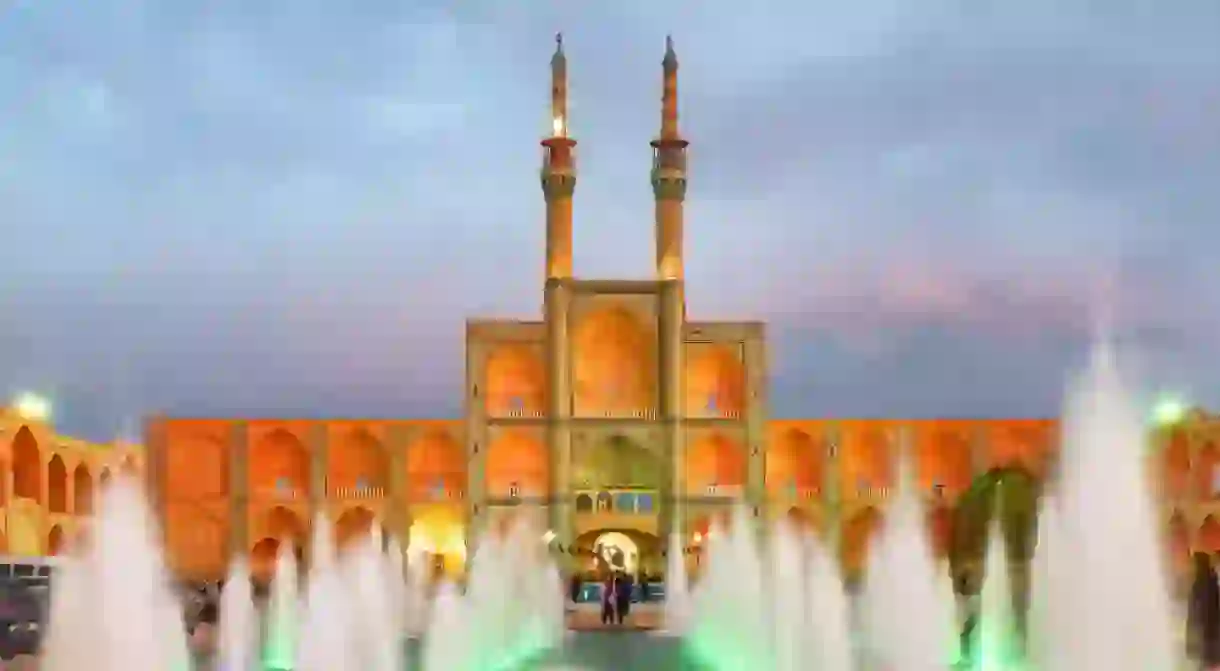The Top 10 Things To See And Do In Yazd, Iran

The desert city of Yazd is as picturesque as Middle Eastern cities come. Its well-preserved mud brick old town, distinctive badgirs, or wind-catchers, dotted around the skyline, and numerous historical sites make it a necessary destination for any tourist visiting Iran. Here we explore the top 10 things to see and do in Yazd.
Amir Chakhmaq Complex
Yazd’s architectural centrepiece, the Amir Chakhmaqcomplex is located in the heart of the city, in a square of the same name. The imposing three-storey façade flaunts a number of beautifully symmetrical iwans, which light up and glow after sunset. It is one of the largest hosseiniehs in the country (buildings used in the commemorative ceremonies for Imam Hossein’s death), and dates back to the 15th century, although it has undergone numerous renovations. The surrounding square has a number of good sweet and ice cream shops. Address: Amir Chakhmaq Square, Yazd
Saheb A Zaman Zurkhaneh
Building

This popular Zurkhaneh (which literally translates to House of Strength) resides in a historic building on the northern side of Amir Chakhmaq Square. Often open to tourists, not only can you observe practitioners of this curious dancing-cum-weightlifting activity that is steeped in Shi’ite mysticism, but also investigate the 15th-century water tank housed beneath the building, and experience the cooling effects of Yazdi badgirs (wind-catchers) first-hand.
Address: northern side of Amir Chakhmaq Square, Yazd
Address: northern side of Amir Chakhmaq Square, Yazd
Zoroastrian Ateshkadeh

Zoroastrianism, an ancient monotheistic religion that dates back to around 3500 years ago, was the principal religion in Iran before the Islamic conquests, and the community still lives on in some parts of the country. Yazd is the centre of Zoroastrianism in Iran, and is home to several sites of religious and historic interest. The Ateshkadeh, or Fire Temple, is the most important, containing a central fire that has allegedly been burning since the 5th century A.D. Address: Mosala Street, Yazd
Towers Of Silence

Another fascinating Zoroastrian site, the ominous-sounding Towers of Silence are located just outside the city and certainly worth a visit. Rising from a solemn desert landscape, these two circular, raised structures sit atop adjacent hills. Until as recently as the 1960s, in accordance with tradition, the bodies of deceased Zoroastrians were left in the towers’ central pits for scavenger birds to pick at. Abandoned Zoroastrian buildings at the base of the hills contribute to the eerie, otherworldly atmosphere of the place.
Address: Shahidan-e Ashraf Boulevard, Yazd
Address: Shahidan-e Ashraf Boulevard, Yazd
Chak Chak

Out in the desert, about 70 kilometres from Yazd, is Iran’s most important Zoroastrian pilgrimage site, Chak Chak. A tiny cliff-side village, according to legend the rock face opened up and offered refuge to Nikbanu, the daughter of the last pre-Islamic ruler, from the encroaching Arab invaders. The temple of Chak Chak, which is the Persian for ‘drip drip,’ contains an ever-dripping spring, said to be the mountain weeping in remembrance of Princess Nikbanu.
Address: Ardakan, Yazd
Address: Ardakan, Yazd
Old Town
Historical Landmark, Architectural Landmark

The well-preserved, still inhabited Old Town in Yazd, with its warren-like streets and intriguing nooks and crannies, is a delight to get lost in whilst on an afternoon stroll. The yellow-brown of the mud-brick buildings demonstrate just how dry this city is, and the badgirs which poke out periodically are a scenic reminder of the ingenuity of Yazd’s traditional architecture. Look out for rooftop access for some unforgettable views, but remember to respect the privacy of the local residents.
Jame Mosque
Mosque

Visible from all around the Old Town is the exquisite Jame Mosque. The 14th-century structure reportedly has the highest minarets in the country, and exemplifies Iranian-Islamic architecture with its delicate blue-mosaic tile work. Some elements of the mosque date back even earlier to the 12th century. The intricacies and inscriptions of the grand iwan are a particular highlight.
Bagh-E Dowlatabad

With an abundance of fountains, cypress trees, and pomegranates, the Bagh-e Dowlatabad can be said to capture the quintessence of the Persian garden. The 18th-century residence offers an abundance of shade and some beautiful buildings, attracting tourists all year round. The 33-metre central badgir, as well as the kaleidoscopic array of stained-glass windows, make for a magically idiosyncratic aesthetic, the likes of which you won’t find elsewhere or soon forget.
Address: Navab Safavi Boulevard, Yazd
Address: Navab Safavi Boulevard, Yazd
Saryazd Fortress

Under-appreciated as a tourist destination, the fortress ruins in the nearby village of Saryazd merit the 45 minute trip from Yazd. The Sassanian-era defensive structure, which is double-walled and three-storeyed in parts, is remarkably well preserved. Developed by the Safavids, the fortress is crumbling in some areas, nevertheless, after a couple of hours here, it’s not hard to see why Yazd has been so historically unconquerable. You will need to find the caretaker to unlock the entrance.
Address: Saryazd, Yazd
Address: Saryazd, Yazd
Kharanaq village

No day trip around Yazd province is complete without an excursion to the centuries-old village of Kharanaq. Reportedly inhabited for over 1000 years, the mud brick village is practically deserted these days, but you’ll see a few farmers still pottering around. Indescribably picturesque, visitors are free to explore the abandoned remains; highlights include a Qajar-era mosque and an ancient aqueduct in the valley below.
Address: Kharanaq, Yazd Province
Address: Kharanaq, Yazd Province













